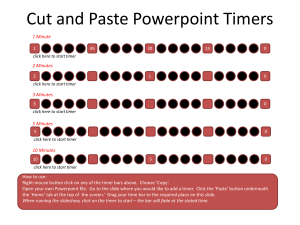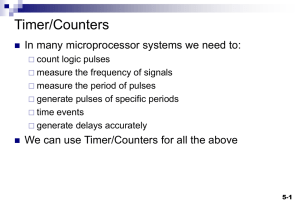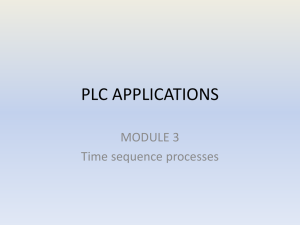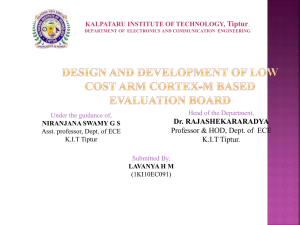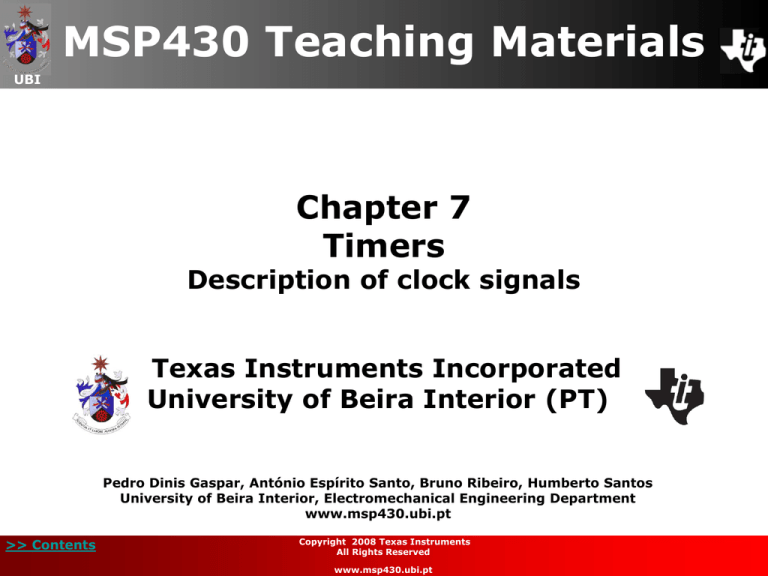
MSP430 Teaching Materials
UBI
Chapter 7
Timers
Description of clock signals
Texas Instruments Incorporated
University of Beira Interior (PT)
Pedro Dinis Gaspar, António Espírito Santo, Bruno Ribeiro, Humberto Santos
University of Beira Interior, Electromechanical Engineering Department
www.msp430.ubi.pt
>> Contents
Copyright 2008 Texas Instruments
All Rights Reserved
www.msp430.ubi.pt
Contents
UBI
Introduction to timers
Clock signals available on the hardware development kits
Basic Timer1
Timer_A and Timer_B:
Operating modes
Reset
Registers
Cap/Com blocks
Output modes
Timer_A Cap/Com registers
Interrupts
Timer_B special features
Timer_B register special bits
Quiz
>> Contents
Copyright 2009 Texas Instruments
All Rights Reserved
www.msp430.ubi.pt
2
Introduction (1/3)
UBI
Correct system timing is a fundamental requirement for
the proper operation of a real-time application;
If the timing is incorrect, the input data may be
processed after the output was updated;
The clock implementations vary among devices in the
MSP430 family;
Each device provides different clock sources, controls
and uses;
This chapter discusses the clock controls provided by the
various MSP430 hardware platforms.
>> Contents
Copyright 2009 Texas Instruments
All Rights Reserved
www.msp430.ubi.pt
3
Introduction (2/3)
UBI
MSP430x4xx family:
Two general purpose 16-bit or 8-bit counters and event
timers: Timer_A, Timer_B;
Basic Timer 1 (MSP430x4xx devices).
MSP430x2xx family:
Also has Timer_A and Timer_B, as above;
Basic Clock Module+.
The timers may be driven from an internal or external
clock;
Timer_A and Timer_B also include multiple independent
capture and compare blocks, with interrupt capabilities;
The capture and compare blocks are suited to
applications such as:
Time events;
Pulse Width Modulator (PWM).
>> Contents
Copyright 2009 Texas Instruments
All Rights Reserved
www.msp430.ubi.pt
4
Introduction (3/3)
UBI
The system timing is fundamental to nearly every
embedded application;
The main applications of timers are to:
• Generate events of fixed time-period;
• Allow periodic wakeup from sleep of the device;
• Count transitional signal edges;
• Replacing delay loops with timer calls allows the CPU to
sleep between operations, thus consuming less power.
>> Contents
Copyright 2009 Texas Instruments
All Rights Reserved
www.msp430.ubi.pt
5
Clock signals
UBI
The clock signals are controlled by two sets of registers
(4xx family):
The first set of registers configures the low-frequency
signals for use by peripheral modules:
• Basic Timer Control Register (BTCTL);
• Basic Timer Counter 1 (BTCNT1);
• Basic Timer Counter 2 (BTCNT2).
The second set of registers is dedicated to the configuration
of general-purpose system clocks:
• System Clock Control (SCFQCTL);
• System Clock Frequency Integrator 0 (SCFI0);
• System Clock Frequency Integrator 1 (SCFI1);
• Frequency Locked Loop control registers (FLL+CTL0,
FLL+CTL1).
>> Contents
Copyright 2009 Texas Instruments
All Rights Reserved
www.msp430.ubi.pt
6
Basic Timer1 (1/5)
UBI
The Basic Timer 1 module consists of two independent 8bit timers:
Basic Timer 1 Counter 1 (BTCNT1);
Basic Timer 1 Counter 2 (BTCNT2).
These can be used in cascade to form a 16-bit timer
(software selectable by BTCTL register configuration);
The main characteristics of this module are:
• Clock for a Liquid Crystal Display (LCD) module;
• Suitable for a Real-Time Clock (RTC) implementation;
• Basic interval timer;
• Simple interrupt capability.
>> Contents
Copyright 2009 Texas Instruments
All Rights Reserved
www.msp430.ubi.pt
7
Basic Timer1 (2/5)
UBI
The control registers determine the operation of the
Basic Timer 1 module:
• BTCNT1 (Read/write 8 bit register) - Generate the fLCD:
– Clock source: ACLK;
– Frame frequency selectable by software (BTFRFQx):
fLCD = ACLK/x.
• BTCNT2 (Read/write 8-bit register) - Programmable
frequency divider to provide periodic CPU interrupts
and/or a RTC system.
– 3 possible clock sources:
» ACLK
» SMCLK
» ACLK/256 - cascaded with BTCNT1 (BTSSEL and
BTDIV bits in the BTCTL register);
– Sources the Basic Timer1 interrupt, BTIFG, with
interval selected by BTIPx bits.
>> Contents
Copyright 2009 Texas Instruments
All Rights Reserved
www.msp430.ubi.pt
8
Basic Timer1 (3/5)
UBI
Block diagram:
>> Contents
Copyright 2009 Texas Instruments
All Rights Reserved
www.msp430.ubi.pt
9
Basic Timer1 (4/5)
UBI
Registers:
BTCTL, Basic Timer 1 Control Register
7
6
5
4
3
2
1
0
BTSSEL
BTHOLD
BTDIV
BTFRFQ1
BTFRFQ0
BTIP2
BTIP1
BTIP0
Bit
Description
7
BTSSEL
BTCNT2 clock select (together with the BTDIV bit)
6
BTHOLD
Basic Timer 1 hold:
5
BTDIV
Basic Timer 1 clock divider: BTSSEL
BTSSEL
BTSSEL
BTSSEL
4-3
BTFRFFQx
LCD frame frequency:
2-0
BTIPX
Basic Timer 1 interrupt interval:
>> Contents
BTHOLD = 0
BTHOLD = 1
BTHOLD = 1
BTDIV
BTDIV
BTDIV
BTDIV
BTFRFQ1
BTFRFQ1
BTFRFQ1
BTFRFQ1
=
=
=
=
0
0
1
1
0
1
0
1
BTFRFQ0
BTFRFQ0
BTFRFQ0
BTFRFQ0
=
=
=
=
BTIP2
BTIP2
BTIP2
BTIP2
BTIP2
BTIP2
BTIP2
BTIP2
0
0
1
1
0
1
0
1
BTIP1
BTIP1
BTIP1
BTIP1
BTIP1
BTIP1
BTIP1
BTIP1
Copyright 2009 Texas Instruments
All Rights Reserved
www.msp430.ubi.pt
BTCNT1 and BTCNT2 active
BTCNT1 hold, if BTDIV = 1
BTCNT1 and BTCNT2 hold
BTIP0
BTIP0
BTIP0
BTIP0
BTIP0
BTIP0
BTIP0
BTIP0
ACLK
ACLK/256
SMCLK
ACLK/256
fACLK/32
fACLK/64
fACLK/128
fACLK/256
=
=
=
=
=
=
=
=
0
0
0
0
1
1
1
1
0
0
1
1
0
0
1
1
0
1
0
1
0
1
0
1
fCLK2
fCLK2
fCLK2
fCLK2
fCLK2
fCLK2
fCLK2
fCLK2
/
/
/
/
/
/
/
/
2
4
8
16
32
64
128
256
10
Basic Timer1 (5/5)
UBI
Registers:
IE2, Interrupt Enable Register 2
7
0
BTIE
Bit
Description
7
BTIE
Basic Timer 1 interrupt enable when BTIE = 1
IFG2, Interrupt Flag Register 2
7
0
BTIFG
Bit
7
Description
BTIFG
>> Contents
Basic Timer 1 interrupt flag BTIFG = 1 when interrupt pending
Copyright 2009 Texas Instruments
All Rights Reserved
www.msp430.ubi.pt
11
Timer_A and Timer_B Introduction (1/6)
UBI
Timer A and B are two general-purpose 16-bit
counter/event timers;
There are slight differences between the two timers;
Features common to both timers include:
Asynchronous 16-bit timer/counter with four
operating modes:
• Timer_A length: 16 bits;
• Timer_B length: programmable: 8, 10, 12, or 16 bits.
• Timer/counter register, TAR (Timer_A) or TBR (Timer_B)
-from now on described as TxR- increments or
decrements (depending on mode of operation) with
each rising edge of the clock signal;
• The timer can generate an interrupt when it overflows;
• Wide interrupt interval range: 1/MCLK to 32 seconds.
>> Contents
Copyright 2009 Texas Instruments
All Rights Reserved
www.msp430.ubi.pt
12
Timer_A and Timer_B Introduction (2/6)
UBI
Choice of selectable and configurable clock source:
• ACLK;
• SMCLK;
• External - via TACLK or INCLK (TASSELx bits);
• The selected clock source may additionally be divided
by 2, 4, or 8 (IDx bits configuration).
Configurable capture/compare registers:
• Timer_A has 3 or 5 capture/compare registers;
• Timer_B has 3 or 7 capture/compare registers;
• Timer_B capture/compare registers can be grouped.
>> Contents
Copyright 2009 Texas Instruments
All Rights Reserved
www.msp430.ubi.pt
13
Timer_A and Timer_B Introduction (3/6)
UBI
Configurable outputs and internal connections to
several other modules:
• Faster response;
• No cycles are wasted while the Interrupt Service Routine
( ISR) loads/executes;
• Avoids CPU wakeup;
• Saves power.
• Outputs capability: Pulse Width Modulation
(PWM);
• Comparator_A;
• Direct Memory Access (DMA);
• Digital-to-Analogue Converter (DAC12).
>> Contents
Copyright 2009 Texas Instruments
All Rights Reserved
www.msp430.ubi.pt
14
Timer_A and Timer_B Introduction (4/6)
UBI
Asynchronous input and output latching:
• Timer_A Capture/Compare (Cap/Com) registers are not
buffered, being updated immediately when written to;
• Timer_B Cap/Com registers are double-buffered with
synchronized loading.
Interrupt vector register for fast decoding of all
Timer_A and Timer_B interrupts:
• TACCR0 (or TBCCR0) interrupt vector for TACCR0 (or
TBCCCR0) CCIFG;
• TAIV (or TBIV) interrupt vector for the remaining CCIFG
flags and TAIFG (or TBIFG).
>> Contents
Copyright 2009 Texas Instruments
All Rights Reserved
www.msp430.ubi.pt
15
Timer_A and Timer_B Introduction (5/6)
UBI
Block diagram (Timer_A):
>> Contents
Copyright 2009 Texas Instruments
All Rights Reserved
www.msp430.ubi.pt
16
Timer_A and Timer_B Introduction (6/6)
UBI
Timers have four modes of operation:
• MCx bits (Timer_A or Timer_B Control Register)
MCx Mode
Description
00
Stop
The timer is halted
01
Up
Up counting mode (from 0x0000 to the value in the
TACCR0 or TBCCR0 register)
10
Continuous Continuous counting mode (from 0x0000 to 0xFFFF)
11
Up/down
>> Contents
Up/down counting mode (from 0x0000 to the value in the
TACCR0 or TBCCR0 register and back down to zero)
Copyright 2009 Texas Instruments
All Rights Reserved
www.msp430.ubi.pt
17
Timer_A and Timer_B operating modes (1/3)
UBI
Up mode:
TxR counts up till it reaches the value in the TxCCR0
register;
TxR->TxCCR0: TACCR0 interrupt flag, CCIFG, is set;
TxR=TxCCR0: EQU0 = 1 (restarts counting in TxR);
TxCCR0->0: TxIFG interrupt flag is set:
• Interrupt period:
tINT = 1/[fCLK/Prescaler/(TxCCR0+1)].
>> Contents
Copyright 2009 Texas Instruments
All Rights Reserved
www.msp430.ubi.pt
18
Timer_A and Timer_B operating modes (2/3)
UBI
Continuous mode:
TxR counts up till it reaches 0xFFFF (65536 counts);
TxR=0xFFFF: TxR counting from zero (next clock pulse);
0xFFFF->0: TxIFG interrupt flag is set:
• Interrupt period: tINT = 1/[fCLK/Prescaler/65536];
(Correct only for TAR; for TBR 4 different end values. See
User’s Guide for additional details).
>> Contents
Copyright 2009 Texas Instruments
All Rights Reserved
www.msp430.ubi.pt
19
Timer_A and Timer_B operating modes (3/3)
UBI
Up/down mode:
TxR counts up till it reaches the value in the TxCCR0
register;
TxCCR0-1 -> TxCCR0: Interrupt flag, CCIFG, is set;
TxR=TxCCR0: Counting is inverted;
0x0001->0x0000: Interrupt flag TxIFG is set:
• Interrupt period: tINT = 1/[fCLK/Prescaler/(TxCCR02];
>> Contents
Copyright 2009 Texas Instruments
All Rights Reserved
www.msp430.ubi.pt
20
Timer_A and Timer_B reset
UBI
The timers can be reset by the following actions:
Writing 0 in the TxR register;
Writing 0 in the TxCCR0 register, provided that the timer is
not in continuous mode;
Setting the TxCLR bit in the Timer Control Register (TxCTL).
>> Contents
Copyright 2009 Texas Instruments
All Rights Reserved
www.msp430.ubi.pt
21
Timer_A and Timer_B registers
UBI
TACTL, Timer_A Control Register
15
10
Unused
9
8
TASSEL1
TASSEL0
7
6
5
4
3
2
1
0
ID1
ID0
MC1
MC0
Unused
TACLR
TAIE
TAIFG
Bit
Description
9-8
TASSELx
Timer_A clock source:
TASSEL1
TASSEL1
TASSEL1
TASSEL1
7-6
IDx
Clock signal divider:
ID1
ID1
ID1
ID1
5-4
MCx
Clock timer operating mode:
2
TACLR
Timer_A clear when TACLR = 1
1
TAIE
Timer_A interrupt enable when TAIE = 1
0
TAIFG
Timer_A interrupt pending when TAIFG = 1
>> Contents
ID0
ID0
ID0
ID0
TASSEL0
TASSEL0
TASSEL0
TASSEL0
=
=
=
=
0
0
1
1
=
=
=
=
0
0
1
1
0
1
0
1
0
1
0
1
MC1
MC1
MC1
MC1
/
/
/
/
MC0
MC0
MC0
MC0
=
=
=
=
Copyright 2009 Texas Instruments
All Rights Reserved
www.msp430.ubi.pt
0
0
1
1
0
1
0
1
TACLK
ACLK
SMCLK
INCLK
1
2
4
8
Stop mode
Up mode
Continuous mode
Up/down mode
22
Timer_A and Timer_B Cap/Com blocks (1/5)
UBI
Timer_A (and Timer_B) contain independent capture
and compare blocks, TACCRx (or TBCCRx);
These blocks may be used to capture timer register
contents, as they are at the time of an event, or to
generate an event when the timer register contents
correspond to the capture/compare register contents,
e.g. to generate time intervals;
The setting of capture/compare is selected by the mode
bit CAP in the individual Capture/Compare Control
registers, TACCTLx (or TBCCTLx)
>> Contents
Copyright 2009 Texas Instruments
All Rights Reserved
www.msp430.ubi.pt
23
Timer_A and Timer_B Cap/Com blocks (2/5)
UBI
Capture mode:
Used to measure the period of time events with minimal
CPU intervention.
Procedure:
• Set the CAP bit to select capture mode;
• Set the SCS bit to synchronize the capture with the next
timer clock (recommended to avoid race conditions);
• The input signal is sampled by the CCIxA (or CCIxB)
input, selected by the CCISx bits in the
Capture/Compare Control Register, TACCTLx (or
TBCCTLx);
>> Contents
Copyright 2009 Texas Instruments
All Rights Reserved
www.msp430.ubi.pt
24
Timer_A and Timer_B Cap/Com blocks (3/5)
UBI
• The capture edge of the input signal (rising, falling, or
both) is selected by the CMx bits;
• When a valid edge is detected on the selected input line,
the value in the Timer register is latched into the
TACCRx (or TBCCRx) register, providing a time mark for
the event;
• The interrupt flag CCIFG is set;
• The bit COV (=1) controls an overflow event when a
second capture is performed, before the value from the
first capture is read.
>> Contents
Copyright 2009 Texas Instruments
All Rights Reserved
www.msp430.ubi.pt
25
Timer_A and Timer_B Cap/Com blocks (4/5)
UBI
Compare mode:
Used for pulse generation or generation of interrupts at
specific time intervals (PWM output signals).
Procedure:
• Reset the CAP bit to select compare mode;
• TxR counts up to the value programmed in the TxCCRx
register;
• When the timer value is equal to the value in the
TxCCRx register, an interrupt is generated:
– Interrupt flag CCIFG is set;
– Internal signal EQUx = 1 (where x is the number of
the CCR channel).
>> Contents
Copyright 2009 Texas Instruments
All Rights Reserved
www.msp430.ubi.pt
26
Timer_A and Timer_B Cap/Com blocks (5/5)
UBI
• EQUx affects the output compare signal OUTx according
to the output mode (defined by the OUTMODx bits in the
TxCCTL;
• The input signal CCI is latched into SCCI.
Output operating modes uses:
Modes 2, 3, 6 and 7: PWM output signals;
Mode 3: active PWM signal at low state;
Mode 7: active PWM signal at high state;
Modes 2 and 6: complementary PWM signals;
Modes 1 and 5: single event generation;
Mode 4: signal with 1/2 frequency of the timer signal.
>> Contents
Copyright 2009 Texas Instruments
All Rights Reserved
www.msp430.ubi.pt
27
Timer_A and Timer_B Output modes (1/2)
UBI
Output operating modes (OUTMODx bits):
OUTMODx
Mode
Description
000
Output
The output signal OUTx is defined by the bit OUTx
001
Set
OUTx = 1 timer = TxCCRx
OUTx = 0 timer = 0 or until another output mode is selected and
affects the output
010
Toggle/Reset
OUTx = toggle timer = TxCCRx
OUTx = 0 timer = TxCCR0
011
Set/Reset
OUTx = 1 timer = TxCCRx
OUTx = 0 timer = TxCCR0
100
Toggle
OUTx = toggle timer = TxCCRx
The output period is double the timer period
101
Reset
OUTx = 0 timer = TxCCRx
OUTx = 1 another output mode is selected and affects the output
110
Toggle/Set
OUTx = toggle timer = TxCCRx
OUTx = 1 timer = TxCCR0
111
Reset/Set
OUTx = 0 timer = TxCCRx
OUTx = 1 timer = TxCCR0
>> Contents
Copyright 2009 Texas Instruments
All Rights Reserved
www.msp430.ubi.pt
28
Timer_A and Timer_B Output modes (2/2)
UBI
Output examples:
>> Contents
Copyright 2009 Texas Instruments
All Rights Reserved
www.msp430.ubi.pt
29
Timer_A Cap/Com registers (1/2)
UBI
TACCTLx, Timer_A Cap/Com Control Register
15
14
13
12
11
10
9
8
CM1
CM0
CCIS1
CCIS0
SCS
SCCI
Unused
CAP
Bit
Description
15-14
CMx
Capture mode:
13-12
CCISx
Capture/compare input select:
11
SCS
Synchronize capture input signal with timer clock:
SCS = 0
Asynchronous capture
SCS = 1
Synchronous capture
10
SCCI
Synchronized capture/compare input
8
CAP
Mode:
>> Contents
CM1
CM1
CM1
CM1
CM0
CM0
CM0
CM0
Capture mode
Compare mode
=
=
=
=
0
0
1
1
0
1
0
1
CCIS1
CCIS1
CCIS1
CCIS1
Copyright 2009 Texas Instruments
All Rights Reserved
www.msp430.ubi.pt
No capture
Capture on rising edge
Capture on falling edge
Capture on both edges
CCIS0
CCIS0
CCIS0
CCIS0
=
=
=
=
0
0
1
1
0
1
0
1
CCIxA
CCIxB
GND
Vcc
CAP = 1
CAP = 0
30
Timer_A Cap/Com registers (2/2)
UBI
TACCTLx, Timer_A Cap/Com Control Register
7
6
5
4
3
2
1
0
OUTMOD2
OUTMOD1
OUTMOD0
CCIE
CCI
OUT
COV
CCIFG
Bit
Description
7-5
OUTMODx
Output mode:
4
CCIE
Capture/compare interrupt enable when CCIE = 1.
3
CCI
Capture/compare input
2
OUT
Output state
1
COV
Capture overflow when COV = 1
0
CCIFG
Capture/compare interrupt flag CCIFG = 1 when interrupt pending
>> Contents
OUTMOD2
OUTMOD2
OUTMOD2
OUTMOD2
OUTMOD2
OUTMOD2
OUTMOD2
OUTMOD2
OUTMOD1
OUTMOD1
OUTMOD1
OUTMOD1
OUTMOD1
OUTMOD1
OUTMOD1
OUTMOD1
Copyright 2009 Texas Instruments
All Rights Reserved
www.msp430.ubi.pt
OUTMOD0
OUTMOD0
OUTMOD0
OUTMOD0
OUTMOD0
OUTMOD0
OUTMOD0
OUTMOD0
=
=
=
=
=
=
=
=
0
0
0
0
1
1
1
1
0
0
1
1
0
0
1
1
0 bit OUT
1 Set
0 Toggle/Reset
1 Set / Reset
0 Toggle
1 Reset
0 Toggle / Set
1 Reset / Set
31
Timer_A and Timer_B Interrupts (1/3)
UBI
Interrupt characteristics:
Capture mode:
• Any CCIFG flag is set when a timer value is captured in
the associated TxCCRx register.
Compare mode:
• Any CCIFG flag is set if TxR counts up to the TxCCRx
value.
• Software may also set or clear a CCIFG flag;
• All CCIFG flags request an interrupt when their
corresponding CCIE bit and GIE bit are set.
>> Contents
Copyright 2009 Texas Instruments
All Rights Reserved
www.msp430.ubi.pt
32
Timer_A and Timer_B Interrupts (2/3)
UBI
Interrupt vectors associated with Timer_A:
TACCR0 interrupt vector for TACCR0 CCIFG:
• TACCR0 CCIFG flag has the highest priority Timer_A
interrupt;
• The TACCR0 CCIFG flag is automatically reset when the
TACCR0 interrupt request is serviced.
>> Contents
Copyright 2009 Texas Instruments
All Rights Reserved
www.msp430.ubi.pt
33
Timer_A and Timer_B Interrupts (3/3)
UBI
Interrupt vectors associated with Timer_A (continued):
TAIV interrupt vector for TACCR1 CCIFG to TACCR4
CCIFG and TAIFG:
• Flags are given priority and combined to source a single
interrupt vector (decreasing priority);
• TAIV determines which flag requests the interrupt;
• Disabling interrupts do not affect the value in TAIV;
• Any access (read/write) of TAIV automatically resets the
highest pending interrupt flag;
• If another interrupt flag is set, another interrupt is
immediately generated after servicing the initial
interrupt.
>> Contents
Copyright 2009 Texas Instruments
All Rights Reserved
www.msp430.ubi.pt
34
Timer_B special features (1/3)
UBI
Programmable length of the TBR register (equivalent to
TAR in Timer_A) to be 8, 10, 12, or 16 bits:
Configurable through selection of the CNTLx bits in TBCTL
(equivalent to TACTL in Timer_A);
The maximum count value, TBR(maximum), for the
selectable lengths is 0FFh, 03FFh, 0FFFh, and 0FFFFh,
respectively;
Three or seven capture/compare blocks TBCCRx;
>> Contents
Copyright 2009 Texas Instruments
All Rights Reserved
www.msp430.ubi.pt
35
Timer_B special features (2/3)
UBI
Double-buffered compare latches with synchronized
loading:
In Timer_A, the signal generation in compare mode may
cause noise during compare period updates because the
TACRRx value is used directly to compare with the timer
value;
To avoid this condition, the compare latches TBCLx, buffered
by TBCCRx, holds the data for the comparison to the timer
value in compare mode;
The CLLDx bits at the TBCCTLx register configure the timing
of the transfer from TBCCRx to TBCLx.
>> Contents
Copyright 2009 Texas Instruments
All Rights Reserved
www.msp430.ubi.pt
36
Timer_B special features (3/3)
UBI
Grouping channels capability:
Multiple compare latches may be grouped together for
simultaneous updates of the TBCLGRPx bits;
Two conditions are required:
• All TBCCRx registers must be updated;
• The load event controlled by the CLLDx bits must occur.
All outputs can be put into a high-impedance state:
TBOUTH = 1 puts Timer_B outputs into a high-impedance
state, allowing higher security and lower delay time
responding to failures.
The SCCI bit function is not implemented.
>> Contents
Copyright 2009 Texas Instruments
All Rights Reserved
www.msp430.ubi.pt
37
Timer_B registers special bits (1/2)
UBI
TBCTL, Timer_B Control Register
15
14
Unused
TBCLGRP1
13
12
11
10
9
8
TBCLGRP0
CNTL1
CNTL0
Unused
TBSSEL1
TBSSEL0
7
6
5
4
3
2
1
0
ID1
ID0
MC1
MC0
Unused
TBCLR
TBIE
TBIFG
Bit
Description
14-13
TBCLGRPx
TBCLx group:
TBCLGRP1 TBCLGRP0 = 0 0
TBCLGRP1 TBCLGRP0 = 0 1
TBCLGRP1 TBCLGRP0 = 1 0
TBCLGRP1 TBCLGRP0 = 1 1
12-11
CNTLx
Counter Length:
>> Contents
CNTL1
CNTL1
CNTL1
CNTL1
Each TBCLx latch loads independently
TBCL1+TBCL2 (update control: TBCCR1 CLLDx)
TBCL3+TBCL4 (update control: TBCCR3 CLLDx)
TBCL5+TBCL6 (update control: TBCCR5 CLLDx)
TBCL0 independent
TBCL1+TBCL2+TBCL3 (update control: TBCCR1 CLLDx)
TBCL4+TBCL5+TBCL6 (update control: TBCCR4 CLLDx)
TBCL0 independent
TBCL0+TBCL1+TBCL2+TBCL3+TBCL4+TBCL5+TBCL6
(update control: TBCCR1 CLLDx)
CNTL0
CNTL0
CNTL0
CNTL0
=
=
=
=
0
0
1
1
0
1
0
1
Copyright 2009 Texas Instruments
All Rights Reserved
www.msp430.ubi.pt
16-bit, TBR(max) = 0FFFFh
12-bit, TBR(max) = 0FFFh
10-bit, TBR(max) = 03FFh
8-bit, TBR(max) = 0FFh
38
Timer_B registers special bits (2/2)
UBI
TBCCTLx, Timer_B Capture/Compare Control Register
15
14
13
12
11
10
9
8
CM1
CM0
CCIS1
CCIS0
SCS
CLLD1
CLLD0
CAP
7
6
5
4
3
2
1
0
OUTMOD2
OUTMOD1
OUTMOD0
CCIE
CCI
OUT
COV
CCIFG
Bit
10-9
Description
CLLDx
Compare latch load:
CLLD1 CLLD0 = 0 0
CLLD1 CLLD0 = 0 1
CLLD1 CLLD0 = 1 0
mode)
>> Contents
CLLD1 CLLD0 = 1 1
TBCLx loads on write to TBCCRx
TBCLx loads when TBR counts to 0
TBCLx loads when TBR counts:
- to 0 (up/continuous mode);
- to TBCL0 or to 0 (up/down
TBCLx loads when TBR counts:
- to TBCLx
Copyright 2009 Texas Instruments
All Rights Reserved
www.msp430.ubi.pt
39
Quiz (1/4)
UBI
1. The timer/counter suitable for LCD controller frame
frequency generation in the MSP430FG4618 is:
(a) Timer_A;
(b) BTCNT2;
(c) Timer_B;
(d) BTCNT1.
2. To set Timer_A to repeatedly count from 0x000 to
0xFFFF, the operating mode selected must be:
(a) Up/Down mode (MCx = 3);
(b) Up mode (MCx = 1);
(c) Continuous (MCx = 2);
(d) Stop (MCx = 0).
>> Contents
Copyright 2009 Texas Instruments
All Rights Reserved
www.msp430.ubi.pt
40
Quiz (2/4)
UBI
3. The Timer_A configured in continuous operating mode
is reset with:
(a) Write 0xFFFF to TAR register;
(b) Reset TACCR0;
(c) Set TACLR bit in the TACTL register;
(d) None of the above.
4. When TASSELx = 1, the timer (Timer_A or Timer_B) is
sourced by:
(a) ACLK;
(b) TACLK;
(c) INCLK;
(d) SMCLK.
>> Contents
Copyright 2009 Texas Instruments
All Rights Reserved
www.msp430.ubi.pt
41
Quiz (3/4)
UBI
5. To generate a PWM signal with an active high state it
is necessary to configure the output operating mode as:
(a) Mode 2;
(b) Mode 3;
(c) Mode 6;
(d) Mode 7.
6. In the case where Timer_A is sourced by the ACLK
(32768 Hz) and is configured in compare mode, the
value in TACCR0 register to enable interrupts once every
second must be:
(a) 32768;
(b) 32767;
(c) 16384;
(d) 65536.
>> Contents
Copyright 2009 Texas Instruments
All Rights Reserved
www.msp430.ubi.pt
42
Quiz (4/4)
UBI
Answers
1. (d) BTCNT1.
2. (c) Continuous (MCx = 2).
3. (c) Set TACLR bit in the TACTL register.
4. (a) ACLK.
5. (d) Mode 7.
6. (b) 32767.
>> Contents
Copyright 2009 Texas Instruments
All Rights Reserved
www.msp430.ubi.pt
43



